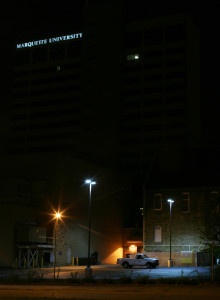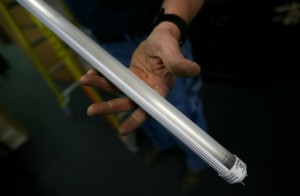We have much more to do and your continued support is needed now more than ever.
The Next Frontier in Lighting: LED

“We installed LED lighting as part of a new pilot program, because it seems to be a natural progression for where new lighting is heading in the future,” said Mike Whittow, assistant to the vice president of administration and the sustainability officer for the Milwaukee, WI, campus. “Yes, it is more expensive,” he says, “but we feel it will pay off in the long-run and is a more sustainable alternative to incandescent or fluorescent lighting.”
Short for light emitting diodes, LEDs are semiconductors that convert electricity into light. There are no moving or fragile parts, making them far more durable than other lights. And there are no toxic materials inside the bulb. After years of usage as Christmas tree string lights and the small red or green indicator buttons on remote controls and electronic devices, LEDs have brightened up, with new versions that emit strong and bright, white light that uses less electricity than any other bulb on the market.
“Universities, which typically run longer hours, need overnight-lit areas for students in walkways and dormitories and have a campus consciousness about the need for energy conservation are very, very interested in LED lighting,” says Deb Loving, an LED programs evangelist for LED University, an industry-sponsored marketing program designed to recruit more campuses to install the lighting.
Until the recent availability of large-scale LED lighting, campuses interested in energy efficient lighting embraced CFLs. Four times more energy efficient than traditional incandescent bulbs, compact fluorescent light bulbs have a life span that stretches across years instead of months. On Marquette’s campus, CFL lights replaced incandescent bulbs several years ago in residence halls that housed 3,500 undergraduates.
But in looking to the future, campus officials at Marquette picked LED lighting for the parking lot and an administrative building because of its greater energy efficiency over time and its low maintenance costs.
Some 22 percent of a building’s emissions come from lighting, according to the Department of Energy, and switching to LED lights is the single biggest way to bring a building’s emissions down swiftly, says Loving. A 2008 report by McKinsey & Company, a national research firm, cited conversion to LED lighting as the single most cost-effective way to reduce global warming.

The other downside, according to some, is aesthetics. One technology analyst told the New York Times that LED illumination can range from a warm light to “alien autopsy.”
Marquette’s LED-outfitted parking lot is a test project only. Despite the expected cost savings, Whittow said campus officials are concerned about not only aesthetics, but the type of light emitted and deliberately settled on a small scale for the outdoor lights. The LED parking lot lights provide only “directional light” rather than the 360-degree diffused light that is typically used in a parking lot, Whittow said. “They’re well suited to walkway lighting, but we think of the parking lot as an experiment,” he said.
Other schools are making the switch to LED, including North Carolina State University, which is completing the biggest LED test project for a public university in the nation. The pilot project includes installation of recessed lights in the Chancellor’s office, a dormitory and student apartments, as well as placing LED lights in campus parking garages. Campus officials estimate that they are achieving an energy savings of 66 percent.
The University of Alaska at Anchorage began converting lighting applications to LED technology five years ago, starting with signage, specialty lighting, aisle lighting in lecture halls and theater stairway lighting. The university recently completed a parking lot pilot with LED fixtures. University estimates put their energy savings at 60 percent in the parking structure.
While there is no central clearinghouse for campus LED usage outside of the industry-sponsored LED University, campus officials say they believe LEDs are rapidly catching on at universities undergoing campus construction and renovation projects. “It’s where the future of lighting is heading,” says Whittow.




















